
The Guardians of the Directions are the deities who rule the specific directions of space according to Hinduism, Jainism and Vajrayāna Buddhism—especially Kālacakra. As a group of eight deities, they are called Aṣṭa-Dikpāla (अष्ट-दिक्पाल), literally meaning guardians of eight directions. They are often augmented with two extra deities for the ten directions, when they are known as the Daśa-Dikpāla. In Hinduism it is traditional to represent their images on the walls and ceilings of Hindu temples. They are also often portrayed in Jain temples, with the exception that Nāga usually takes the place of Vishnu in the nadir. Ancient Java and Bali Hinduism recognize Nava-Dikpāla, literally meaning guardians of nine directions, that consist of eight directions with one addition in the center. The nine guardian gods of directions is called Dewata Nawa Sanga. The diagram of these guardian gods of directions is featured in Surya Majapahit, the emblem of Majapahit empire.
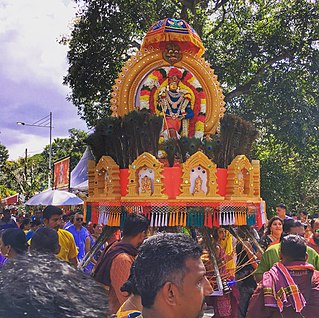
Thaipusam or Thaipoosam is a Tamil Hindu festival celebrated on the first full moon day of the Tamil month of Thai coinciding with Pusam star. The festival is celebrated to commemorate the victory of Hindu god Murugan over the demon Surapadman using a vel, a divine spear granted by his mother, Parvati.

Banda Aceh is the capital and largest city in the province of Aceh, Indonesia. It is located on the island of Sumatra and has an elevation of 35 meters. The city covers an area of 61.36 square kilometers (23.69 sq mi) and had a population of 223,446 people at the 2010 Census, rising to 252,899 at the 2020 Census. The official estimate as at mid 2023 was 261,969.

A spirit house is a shrine to the protective spirit of a place that is found in the Southeast Asian countries of Burma, Cambodia, Laos, Thailand, Malaysia, Indonesia, Vietnam and the Philippines. They are normally in the form of small roofed structure mounted on a pillar or a dais, and can range in size from small platforms to houses large enough for people to enter. Spirit houses are intended to provide a shelter for spirits that could cause problems for the people if not appeased. They often include images or carved statues of people and animals. Votive offerings are left at them to propitiate the spirits; more elaborate installations include an altar for this purpose.

The Subramaniya Swamy Temple, Tiruchendur is an ancient Hindu temple dedicated to Murugan (Kartikeya). It is second among six abodes of Murugan situated in Tamil Nadu, India. It is located in the eastern end of the town Tiruchendur in the district of Thoothukudi, Tamil Nadu, India. It is 40 km from Thoothukudi, 60 km south-east of Tirunelveli and 75 km north-east of Kanyakumari. The temple complex is on the shores of Bay of Bengal.

Devata are smaller and more focused Devas (Deities) in Indian religions, such as Hinduism and Buddhism. The term "devata" itself can also mean deva. They can be either male or female. Every human activity has its devata, its spiritual counterpart or aspect.
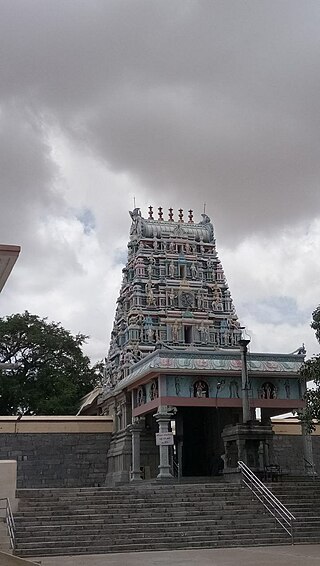
Kangeyam is a historical town and municipality in Kangeyam Taluk of Tiruppur district in the Indian state of Tamil Nadu. It is situated on National Highway 81. Kangeyam is an economic center in Tamil Nadu. The main commercial interests of the municipality are rice hulling, coconut oil extraction, ghee production, and groundnut cultivation. The town is located 28 km from the district headquarters at Tiruppur, 45 km from the city of Erode, 70 km from the industrial town of Coimbatore,30 km from the town of Dharapuram, 55 km from the city of Karur, 140 km from the Ancient city of Trichy and 441 km from the state capital Chennai.

Vel is a divine spear associated with Murugan, the Hindu god of war.

The Arulmigu Sri Mahamariamman Temple is a Hindu temple within George Town in the Malaysian state of Penang. The oldest Hindu temple in the state, it was built in 1833, and features sculptures of gods and goddesses over its main entrance and facade.
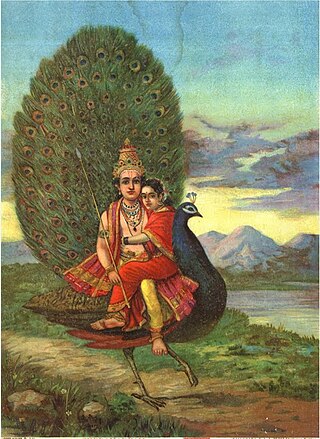
Kavadi Aattam is a ceremonial sacrifice and offering practiced by devotees during the worship of Murugan, the Hindu god of war. It is a central part of the festival of Thaipusam and emphasizes debt bondage. The Kavadi ("burden") itself is a physical burden, the bearing of which is used by the devotee to implore Murugan for assistance, usually on behalf of a loved one who is in need of healing, or as a means of balancing a spiritual debt. Devotees process and dance along a pilgrimage route while bearing these burdens.

Arulmigu Dhandayuthapani Swamy Temple is third of the Six Abodes of Murugan. It is located in the city of Palani, Dindigul district, 100 kilometres (62 mi) southeast of Coimbatore and northwest of Madurai in the foothills of the Palani Hills, Tamil Nadu, India. Known as Thiruaavinankudi in the old Sangam literature of Thirumurugatrupadai, Palani temple is considered synonymous with Panchamritam, a sweet mixture made of five ingredients.
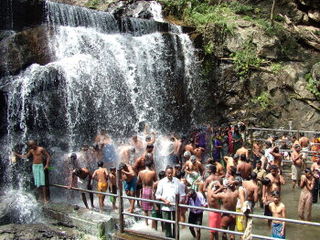
Suruli falls, is located 56 km (35 mi) from Theni and 10 km (6.2 mi) from Cumbum in the Theni District in Tamil Nadu, India. It is a 2 stage Cascading water fall. The Suruli River supplying the falls originates from the Meghamalai mountain range. The falls drop from a height of 150 feet (46 m) gathers into a pool, flows for a short distance and again plummets an additional 40 feet (12 m).

Vaidyanatha Ganapati Sthapati was a Sthapati and head of the College of Architecture and Sculpture in the Vastu Shastra tradition ascribed to the sage Mamuni Mayan.

Vadapalani Andavar Temple is a Hindu temple dedicated to Lord Muruga. It is located in Vadapalani, Chennai, Tamil Nadu, India. It was renovated in the 1920s and a Rajagopuram was built during that time. The temple has grown in popularity, which is believed to be in part due to the patronage of cinema stars.
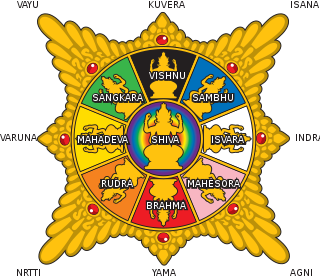
Surya Majapahit is the emblem commonly found in ruins dated from the Majapahit era. The emblem commonly took the form of an eight-pointed sun ray with the rounded part in the center depicting Hindu deities. The emblem might have taken the form of a cosmological diagram haloed by typical sun rays, or a simple circle with typical sun rays. Because of the popularity of the Surya emblem during the Majapahit era, it has been suggested that may have served as the imperial symbol of the Majapahit empire.
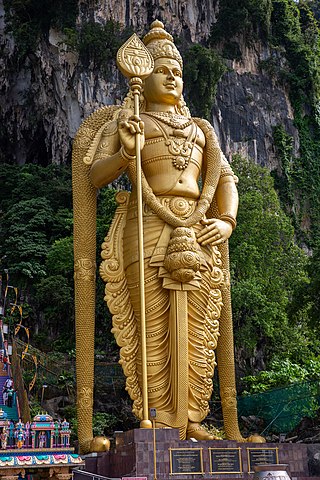
Kartikeya, also known as Skanda, Subrahmanya, Shanmukha and Murugan, is the Hindu god of war. He is the son of Shiva and Parvati and the brother of Ganesha.
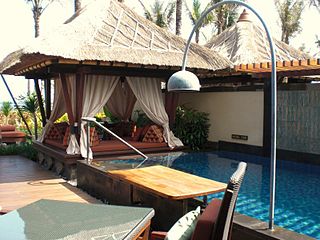
Balinese architecture is a vernacular architecture tradition of Balinese people that inhabits the volcanic island of Bali, Indonesia. Balinese architecture is a centuries-old architectural tradition influenced by Balinese culture developed from Hindu influences through ancient Javanese intermediary, as well as pre-Hindu elements of native Balinese architecture.

Sri Mariamman Temple is Medan's oldest Hindu Temple. This temple was built in 1884 for the worship of Goddess Mariamman. The temple is situated in the area known as Kampung Madras or Medan's Little India. This temple is also devoted to the Hindu Gods Ganesha, and Murugan, children of Mariamman. The Gate is decorated by gopuram, namely storey tower which can usually be found at the gate of the Hindus temples in South India. The temple is a meeting point for worshippers during Thaipusam and Deevapali festivals.

The Arulmigu Balathandayuthapani Temple, also known as the Waterfall Hilltop Temple, is a Hindu temple within George Town in the Malaysian state of Penang. Dedicated to Lord Murugan, the hilltop temple, with its seven-storey 21.6 m-tall gopuram, has been touted as the largest Lord Murugan temple outside India. It is sited comparatively higher above ground than Batu Caves, with devotees having to climb over 500 steps to access the place of worship.

Uthiyur is a small town in Kangeyam taluk of Tiruppur district in south Indian state of Tamil Nadu.



















